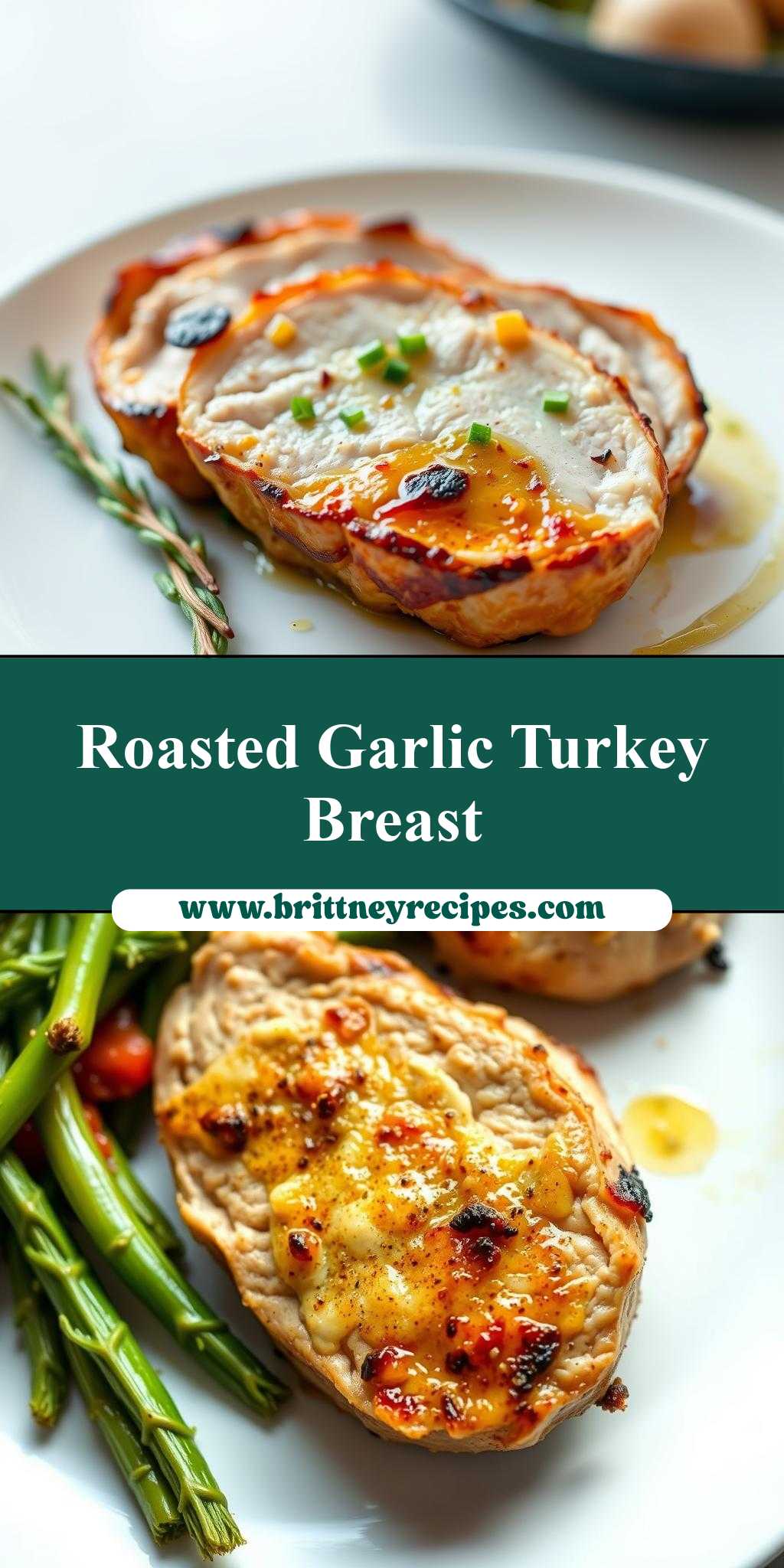What makes the perfect weeknight dinner even better? A juicy turkey breast smothered in rich roasted garlic butter, that’s what. This easy homemade recipe is a family favorite, with tender turkey and savory garlic flavors. Roasting to perfection is simpler than you think, especially with a compound butter made from roasted garlic. Save this idea for your next quick and delicious weeknight dinner solution, perfect for a homemade family meal, and try it soon
Roasted Garlic Butter Turkey Breast
Introduction
There’s nothing quite like a perfectly roasted turkey breast, especially when it’s infused with the rich flavors of garlic butter. This recipe for Roasted Garlic Butter Turkey Breast is a masterclass in simplicity and flavor, using everyday ingredients to create a dish that’s both impressive and easy to make. Whether you’re a seasoned chef or a beginner in the kitchen, this recipe is sure to become a staple in your household. With its perfect balance of savory, aromatic, and slightly sweet notes, it’s the perfect centerpiece for any meal, from a weeknight dinner to a special occasion.
Why This Works
- Flavor balance and ingredient accessibility: The combination of roasted garlic, butter, and turkey breast creates a harmonious balance of flavors that is both satisfying and delicious. The ingredients are also easily accessible, making this dish a practical choice for any occasion.
- Ease of preparation: Despite its impressive results, this recipe requires minimal effort and preparation time, making it an ideal choice for busy individuals or those new to cooking.
- Impressive results with minimal effort: The end result of this recipe is a beautifully roasted turkey breast with a golden-brown crust and a juicy, tender interior, all achieved with surprisingly little effort.
Key Ingredients
The key ingredients in this recipe include a boneless, skinless turkey breast, roasted garlic, butter, salt, pepper, and any desired herbs or spices. For the roasted garlic, you’ll need 3-4 cloves of garlic, which can be roasted in the oven until soft and mashed. The butter should be softened to room temperature for easy mixing with the garlic and herbs. If you prefer a lighter flavor, you can also use olive oil or a combination of butter and oil. Practical substitutions for the herbs include thyme, rosemary, or parsley, depending on your personal taste preferences.
Instructions
- Step 1: Begin by preheating your oven to 375°F (190°C). While the oven is heating up, prepare your ingredients by rinsing the turkey breast and patting it dry with paper towels. Peel the garlic cloves and place them in a piece of aluminum foil, drizzling with a little olive oil and folding the foil to create a packet. Roast the garlic in the oven for about 20-25 minutes, or until it’s soft and mashed.
- Step 2: In a small bowl, mix the softened butter with the roasted garlic, salt, pepper, and any desired herbs until you have a smooth, well-combined paste. Set the garlic butter aside until you’re ready to use it.
- Step 3: Place the turkey breast in a roasting pan or a large oven-safe skillet, and spread the garlic butter evenly over the top of the breast, making sure to get some under the skin as well if it’s not completely skinless. If using any additional herbs or spices, sprinkle them over the top of the breast at this stage.
- Step 4: Roast the turkey breast in the preheated oven for about 20-25 minutes per pound, or until it reaches an internal temperature of 165°F (74°C). Baste the breast with pan juices every 20 minutes to keep it moist and promote even browning. Once the turkey is cooked, remove it from the oven and let it rest for 10-15 minutes before slicing and serving.
Handy Tips
- For a crisper skin, pat the turkey breast dry with paper towels before applying the garlic butter, and make sure the skin is uncovered during roasting. If the skin starts to brown too quickly, you can cover the breast loosely with aluminum foil to prevent overbrowning.
- Use a meat thermometer to ensure the turkey is cooked to a safe internal temperature. The temperature should be checked in the thickest part of the breast, avoiding any bones or fat.
- Don’t overcrowd the roasting pan, as this can affect air circulation and lead to uneven cooking. If necessary, cook the turkey breast on a large baking sheet or use a wire rack to elevate it and improve air flow.
Heat Control
Heat control is crucial when roasting a turkey breast to ensure it cooks evenly and reaches a safe internal temperature. The ideal temperature for roasting is 375°F (190°C), and the breast should be cooked for about 20-25 minutes per pound. It’s also important to baste the breast with pan juices every 20 minutes to keep it moist and promote browning. To check for doneness, insert a meat thermometer into the thickest part of the breast. The turkey is done when it reaches an internal temperature of 165°F (74°C). You can also check for doneness by cutting into the breast; the juices should run clear, and the meat should feel firm to the touch.
Crunch Factor
The crunch factor in this recipe comes from the crispy skin on the turkey breast, which is achieved by patting the breast dry before roasting and ensuring good air circulation around the meat. If you prefer a crisper skin, you can also broil the breast for an additional 2-3 minutes after roasting, watching carefully to prevent burning. The texture of the meat itself should be tender and juicy, with a satisfying firmness that indicates it’s cooked to perfection.
Pro Kitchen Tricks
- Tent the turkey breast with foil if the skin starts to brown too quickly, to prevent overbrowning and promote even cooking.
- Let the turkey rest for 10-15 minutes before slicing, to allow the juices to redistribute and the meat to relax. This makes it easier to slice the breast thinly and evenly.
- Use the pan juices to make a delicious gravy, by deglazing the roasting pan with a little wine or broth and whisking in some flour or cornstarch to thicken.
Storage Tips
- Leftover turkey breast can be stored in the refrigerator for up to 3 days, wrapped tightly in plastic wrap or aluminum foil. It can also be frozen for up to 2 months, wrapped tightly in plastic wrap or aluminum foil and placed in a freezer-safe bag.
- To reheat the turkey breast, slice it thinly and wrap it in foil. Heat it in the oven at 275°F (135°C) for about 10-15 minutes, or until warmed through. You can also reheat it in the microwave, wrapped in a damp paper towel to prevent drying out.
- The shelf life of the turkey breast depends on how it’s stored. In the refrigerator, it’s best consumed within 3 days. In the freezer, it’s best consumed within 2 months. Always check the breast for signs of spoilage before consuming, such as an off smell or slimy texture.
Gift Packaging Ideas
If you’re giving the roasted turkey breast as a gift, consider packaging it in a beautiful wooden or ceramic dish, wrapped in decorative paper or a tea towel. You could also package it in a gift basket filled with other delicious treats, such as artisanal cheeses, crackers, and jams. For a more rustic presentation, wrap the breast in parchment paper or butcher’s paper, tied with twine and finished with a sprig of fresh herbs.
Flavor Variations
- Different spices: Try adding some dried or fresh herbs to the garlic butter, such as thyme, rosemary, or parsley, for a unique flavor twist. You could also add some grated lemon zest or a squeeze of fresh lemon juice for a bright, citrusy note.
- Creative toppings: Consider topping the turkey breast with some caramelized onions or bell peppers, or a spoonful of salsa or chutney. You could also sprinkle some crumbled blue cheese or chopped nuts over the top for added texture and flavor.
- Ingredient swaps: For a dairy-free version, swap the butter for a vegan alternative such as Earth Balance or coconut oil. You could also use olive oil or avocado oil for a lighter, more neutral flavor.
Troubleshooting
- Texture problems: If the turkey breast is too dry, it may be overcooked. Try reducing the cooking time or temperature next time. If the breast is too pink, it may be undercooked. Try increasing the cooking time or temperature next time.
- Ingredient replacements: If you don’t have garlic, you can substitute it with a similar amount of shallots or onions. If you don’t have butter, you can substitute it with a similar amount of oil or margarine.
- Over/undercooking signs: Check the turkey breast for signs of overcooking, such as a dry, white interior or a tough, chewy texture. Check for signs of undercooking, such as a pink interior or a soft, squishy texture.
FAQs
- Can I freeze it? Yes, you can freeze the roasted turkey breast for up to 2 months. Wrap it tightly in plastic wrap or aluminum foil and place it in a freezer-safe bag.
- Is it gluten-free? Yes, this recipe is gluten-free, making it a great option for those with gluten intolerance or sensitivity. Just be sure to check the ingredients of any store-bought broth or wine used in the recipe.
- Can I double the recipe? Yes, you can double the recipe to feed a larger crowd. Just be sure to adjust the cooking time and temperature accordingly, and use a larger roasting pan or skillet to accommodate the increased amount of meat.
Conclusion
In conclusion, this recipe for Roasted Garlic Butter Turkey Breast is a delicious and impressive dish that’s perfect for any occasion. With its rich, savory flavors and tender, juicy texture, it’s sure to become a staple in your household. Whether you’re a seasoned chef or a beginner in the kitchen, this recipe is easy to follow and requires minimal effort and preparation time. So go ahead, give it a try, and enjoy the delicious results!

